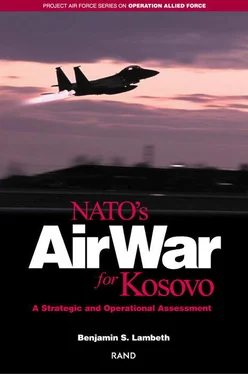Benjamin S. Lambeth
NATO’S AIR WAR FOR KOSOVO
A Strategic and Operational Assessment
Prepared for the United States Air Force
Project AIR FORCE
RAND
Approved for public release; distribution unlimited
On March 24, 1999, NATO embarked on a 78-day air war aimed at compelling the government of Yugoslavia and its elected president, Slobodan Milosevic, to halt and reverse the human rights abuses that were being committed by armed Serbs against the ethnic Albanian majority living in Yugoslavia’s Serbian province of Kosovo. That effort, called Operation Allied Force, ended on June 9 after Milosevic finally acceded to NATO’s demands and a withdrawal of Serb forces from Kosovo had begun. The air war was a first of that magnitude for NATO and represented the third largest strategic application of air power by the United States since World War II, exceeded only by the Vietnam War and Operation Desert Storm in scale and intensity.
With a view toward capturing the many useful insights to be extracted from that experience, the U.S. Air Force chief of staff, General Michael Ryan, asked Headquarters United States Air Forces in Europe (Hq USAFE) shortly after Allied Force ended to establish a studies and analysis office (USAFE/SA) to manage all USAF-sponsored assessments of the air war. The director of that office, Brigadier General John Corley, in turn asked RAND’s Project AIR FORCE to contribute to the assessment effort across a wide spectrum of topics, ranging from individual platform and systems performance to command and control, operational support, strategy and planning, and other considerations bearing on the air war’s effectiveness.
This book examines the conduct and results of Operation Allied Force at the strategic and operational levels. An earlier and less developed version appeared as a chapter in the author’s previous book The Transformation of American Air Power , which was published by Cornell University Press in September 2000. The research documented herein was carried out in Project AIR FORCE’s Strategy and Doctrine Program and was completed in August 2001. All photographs included in this study were provided by the U.S. Department of Defense. The book should be of interest to USAF officers and other members of the U.S. national security community concerned with strategy and force employment issues raised by NATO’s air war for Kosovo and with the implications of that experience for force development, air power doctrine, and concepts of operations for joint and coalition warfare.
Other documents published in this series currently include the following:
MR-1279-AF, Command and Control and Battle Management: Experiences from the Air War over Serbia , James E. Schneider, Myron Hura, Gary McLeod (Government publication; not releasable to the general public)
MR-1326-AF, Aircraft Weapon Employment in Operation Allied Force , William Stanley, Carl Rhodes, Robert Uy, Sherrill Lingel (Government publication; not releasable to the general public)
MR-1351-AF, The Conflict over Kosovo: Why Milosevic Decided to Settle When He Did , Stephen Hosmer
MR-1391-AF, European Contributions to Operation Allied Force: Implications for Transatlantic Cooperation , John E. Peters, Stuart Johnson, Nora Bensahel, Timothy Liston, Traci Williams
DB-332-AF, Aircraft Survivability in Operation Allied Force , William Stanley, Sherrill Lingel, Carl Rhodes, Jody Jacobs, Robert Uy (Government publication; not releasable to the general public)
Topics examined in series documents nearing completion include:
• Supporting Expeditionary Aerospace Forces: Lessons from the Air War Over Serbia
• Lessons Learned from Operation Allied Force Tanker Operations
Project AIR FORCE
Project AIR FORCE, a division of RAND, is the Air Force’s federally funded research and development center (FFRDC) for studies and analysis. It provides the USAF with independent analyses of policy alternatives affecting the deployment, employment, combat readiness, and support of current and future air and space forces. Research is performed in four programs: Aerospace Force Development; Manpower, Readiness, and Training; Resource Management; and Strategy and Doctrine.
2.1. Allied Force Area of Operations Figure 2.1—Allied Force Area of Operations For his part, General Clark had called for punitive air strikes against Yugoslavia as early as January 1999, in response to the Serb massacre of 45 Kosovar Albanians near the town of Racak just days before. Persistent pressures from within NATO to explore a diplomatic solution, however, outweighed that recommendation for the early use of force. The resulting delay gave Milosevic time to bolster his forces, disperse important military assets, hunker down for an eventual bombing campaign, and lay the final groundwork for the ethnic cleansing of Kosovo. Owing to that delay, NATO lost any element of surprise that may otherwise have been available. [14] In the end, Operation Allied Force came just 10 days short of NATO’s 50th anniversary. The Clinton administration did not seek a UN Security Council resolution approving the air attack plan, since it knew that Russia and China had both vowed to veto any proposal calling for air strikes. [15] NATO’s going-in expectation was that the bombing would be over very quickly. Indeed, so confident were its principals that merely a token bombing effort would suffice to persuade Milosevic to yield that the initial attack was openly announced in advance, with U.S. officials conceding up front that it would take a day or more to program all of the TLAMs to hit some 60 planned aim points. [16] Only at the last minute did NATO’s political leaders give Secretary General Solana authority for what one NATO official called a “much more diverse target list, a more intensive pace of operations, and an expanded geographical zone.” [17] Once under way, the slowly escalating air effort put the United States into two simultaneous regional conflicts (the other being Operations Northern and Southern Watch against Iraq) for the first time since World War II. It also made for a uniquely demanding test for American air power and became the most serious foreign policy crisis of the Clinton presidency.
3.1. U.S. and Allied Aircraft Contributions
3.2. In-Theater Aircraft Buildup
3.3. U.S. and Allied Sorties Flown
3.4. USAF Sortie Breakdown by Aircraft Type
3.5. U.S. and Allied Ground-Attack Munitions Expended
3.6. U.S. and Allied Munitions Expenditures by Type
3.7. Total Numbers of Munitions Expended
5.1. U.S. Precision and Nonprecision Munitions Expended
6.1. Enemy SAM Launches Reported
6.2. HARM Expenditures by Target Type
6.3. Short Tonnage Delivered by USAF Airlift
6.4. USAF Aircraft Types Employed
7.1. Operation Allied Force Planning and Implementation
7.2. U.S. and Allied Organization for Allied Force
8.1. Refugee Flow
Between March 24 and June 9, 1999, NATO, led by the United States, conducted an air war against Yugoslavia in an effort to halt and reverse the human-rights abuses that were being committed against the citizens of its Kosovo province by Yugoslavia’s president, Slobodan Milosevic. That 78-day air war, called Operation Allied Force, represented the third time during the 1990s in which air power proved pivotal in determining the outcome of a regional conflict.
Читать дальше













